How to print Integer values in Python
Last updated: Apr 9, 2024
Reading time·5 min

# Table of Contents
- Print integer values in Python
- Print an integer using a formatted string literal
- Print a string and an integer together using addition (+) operator
- Print integer values using the int() class
- Print integer values using sys.stdout.write()
- Print a string and an integer together using commas
- Print a string and an integer using str.format()
# Print integer values in Python
Use the print() function to print an integer value, e.g. print(my_int).
If the value is not of type integer, use the int() class to convert it to an
integer and print the result, e.g. int(my_str).
my_int = 1234567 # ✅ print integer print(my_int)
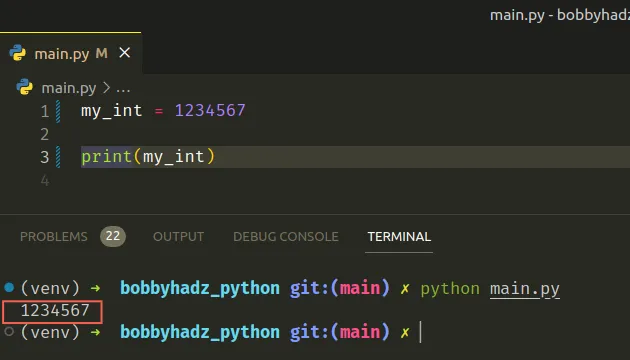
We used the print() function to print integer values.
The print() function takes one or more
objects and prints them to sys.stdout.
If you have an integer value, you can directly pass it to the print() function
to print it.
print(100) # 👉️ 100 print(200) # 👉️ 200
# The print() function returns None
Note that the print() function returns None, so
don't try to store the result of calling print in a variable.
my_int = 1234567 # ⛔️ BAD (print always returns None) result = print(my_int) print(result) # 👉️ None
# Print an integer using a formatted string literal
You can also use a formatted string literal to print an integer.
my_int = 1234567 result = f'The number is {my_int}' print(result) # 👉️ The number is 1234567
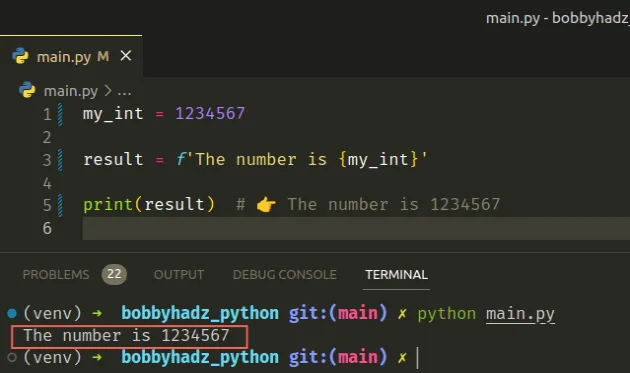
f.my_str = 'The number is:' my_int = 5000 result = f'{my_str} {my_int}' print(result) # 👉️ The number is: 5000
Make sure to wrap expressions in curly braces - {expression}.
# Print a string and an integer together using addition (+) operator
To print a string and an integer together:
- Use the
str()class to convert the integer to a string. - Use the addition (+) operator to concatenate the two strings.
- Use the
print()function to print the result.
my_int = 100 result = 'The number is ' + str(my_int) print(result) # 👉️ The number is 100
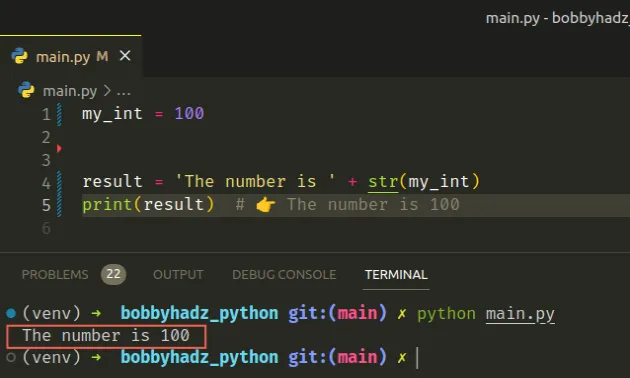
We used the str() class to convert the integer to a string.
If you try to use the addition (+) operator with a string and an integer, you'd get an error.
my_int = 100 # ⛔️ TypeError result = 'The number is ' + my_int
To get around this, we have to use the str() class to convert the integer to a
string.
# Print integer values using the int() class
If your integer is wrapped in a string, use the int() class to convert it to
an integer before printing it.
my_str = '1234567' my_int = int(my_str) print(my_int) # 👉️ 1234567
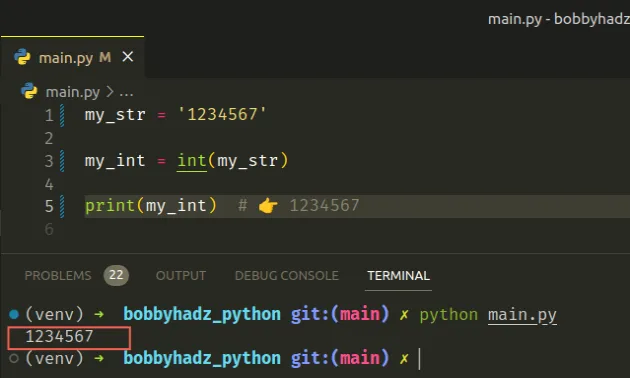
We used the int() class to convert the integer to a string before printing it.
The int() class returns an integer object constructed from the provided number or string argument.
print(int('105')) # 👉️ 105 print(int('5000')) # 👉️ 5000
The constructor returns 0 if no arguments are given.
# Print integer values using sys.stdout.write()
You can also use the stdout.write() method from the sys module to print
integer values.
import sys my_int = 123456 # 👇️ The number is 123456 sys.stdout.write('The number is ' + str(my_int))
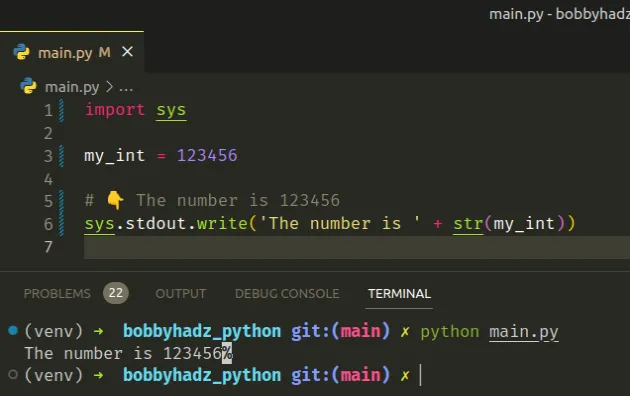
The print() function is actually a thin wrapper around sys.stdout.write.
The print() function uses the sys.stdout.write method under the hood by
default.
Notice that we used the str() class to convert the integer to a string before
using the addition (+) operator.
This is necessary because the values on the left and right-hand sides of the addition (+) operator need to be of compatible types.
# Print a string and an integer together using commas
Alternatively, you can pass multiple, comma-separated arguments to the print()
function.
my_int = 100 # 👇️ The number is 100 print('The number is ', my_int, sep='') # 👇️ The number is 100 print('The number is ', my_int)
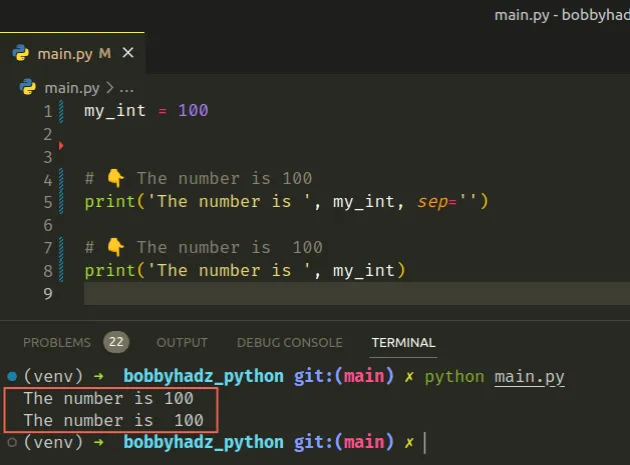
We passed multiple, comma-separated arguments to the print() function to print
a string and an integer.
sep keyword argument if you need to adjust the separator between the values.By default, the sep argument is set to a space.
By setting the argument to an empty string, no extra whitespace is added between the values.
print('a', 'b', 'c', sep="_") # 👉️ "a_b_c" print('a', 'b', 'c', sep="_", end="!!!") # 👉️ "a_b_c!!!"
The string we passed for the end keyword argument is inserted at the end of the string.
The end argument is set to a newline character (\n) by default.
# Print a string and an integer using str.format()
This is a two-step process:
- Use the
str.format()method to interpolate the variable in the string. - Use the
print()function to print the result.
my_int = 247 result = "The integer is {}".format(my_int) print(result) # 👉️ "The integer is 247"
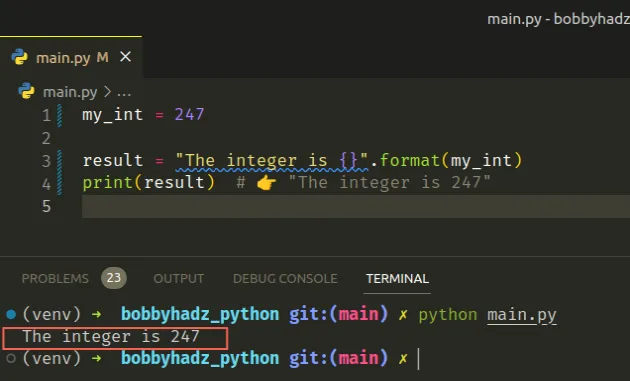
The str.format() method performs string formatting operations.
first = 'Bobby' last = 'Hadz' result = "His name is {} {}".format(first, last) print(result) # 👉️ "His name is Bobby Hadz"
The string the method is called on can contain replacement fields specified
using curly braces {}.
Make sure to provide exactly as many arguments to the format() method as you
have replacement fields in the string.
The str.format() method takes care of automatically converting the integer to
a string.
# Checking what type a variable stores
If you aren't sure what type a variable stores, use the built-in type() class.
my_int = 123 print(type(my_int)) # 👉️ <class 'int'> print(isinstance(my_int, int)) # 👉️ True my_str = 'hello' print(type(my_str)) # 👉️ <class 'str'> print(isinstance(my_str, str)) # 👉️ True
The type class returns the type of an object.
The isinstance function returns
True if the passed-in object is an instance or a subclass of the passed-in
class.
If you need to convert a value to an integer and print the result, use the
int() class.
# Additional Resources
You can learn more about the related topics by checking out the following tutorials:
- Print a Dictionary in Table format in Python
- How to Print on the Same Line in Python
- How to Print a Horizontal Line in Python
- How to print Boolean values in Python
- How to Print a List in Columns in Python
- Print a List without the Commas and Brackets in Python
- Print New Line after a Variable in Python
- How to Print the output of a Function in Python
- How to Print specific items in a List in Python
- Print specific key-value pairs of a dictionary in Python
- How to repeat a String N times in Python
- How to print Bold text in Python [5 simple Ways]
- Using nested Loops to print a Rectangle in Python
- How to print a Timestamp for Logging in Python

